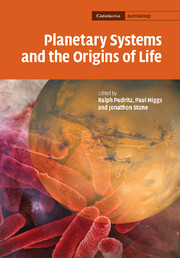Book contents
- Frontmatter
- Contents
- List of contributors
- Preface
- Part I Planetary systems and the origins of life
- Part II Life on Earth
- Part III Life in the Solar System?
- 12 The search for life on Mars
- 13 Life in the dark dune spots of Mars: a testable hypothesis
- 14 Titan: a new astrobiological vision from the Cassini–Huygens data
- 15 Europa, the ocean moon: tides, permeable ice, and life
- Index
15 - Europa, the ocean moon: tides, permeable ice, and life
Published online by Cambridge University Press: 13 August 2009
- Frontmatter
- Contents
- List of contributors
- Preface
- Part I Planetary systems and the origins of life
- Part II Life on Earth
- Part III Life in the Solar System?
- 12 The search for life on Mars
- 13 Life in the dark dune spots of Mars: a testable hypothesis
- 14 Titan: a new astrobiological vision from the Cassini–Huygens data
- 15 Europa, the ocean moon: tides, permeable ice, and life
- Index
Summary
Introduction: life beyond the habitable zone
As the horizons of the field of astrobiology have extended to the rapidly growing population of known extrasolar planetary systems, the concept of a habitable zone around each star has been of particular interest. With each discovery, the question is raised of whether the new planet is in the so-called habitable zone, or whether hypothetical orbits within that zone would be stable. In this context, the habitable zone is commonly defined as a range of distances from the star where temperatures would be in a range for life to be viable and for water to exist near the surface in a phase able to support living organisms (Kasting et al., 1993; Menou and Tabachnik, 2003; Raymond and Barnes, 2005). This restrictive definition can contribute to a relatively pessimistic view of the potential for extra-terrestrial life (e.g., Ward and Brownlee (2000)). It has even been used to advocate planetary exploration objectives, purportedly motivated by the search for life, that are restricted to the terrestrial planets in our Solar System (e.g., Hubbard (2005)).
Unless corrected, this widespread semantic usage of the term habitable zone would leave out one of the most likely places for exploration to reveal extraterrestrial life: Jupiter's moon Europa. The analyses cited above neglect tidal friction, which is known in the case of Jupiter's Galilean satellites to provide significant heating, comparable in fact to the solar heating in the habitable (and inhabited) terrestrial-planet zone.
- Type
- Chapter
- Information
- Planetary Systems and the Origins of Life , pp. 285 - 312Publisher: Cambridge University PressPrint publication year: 2007



